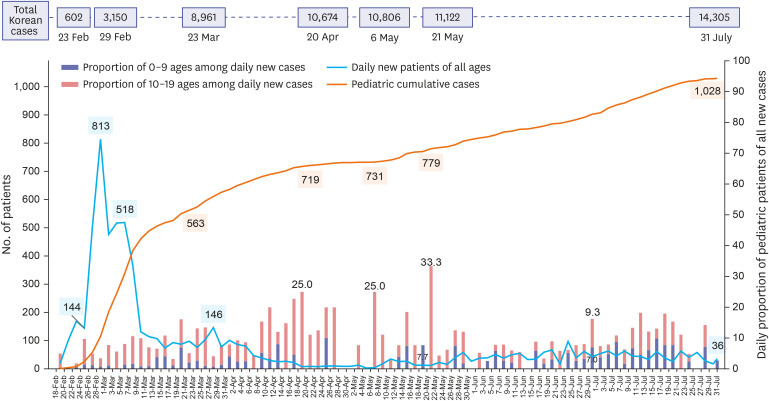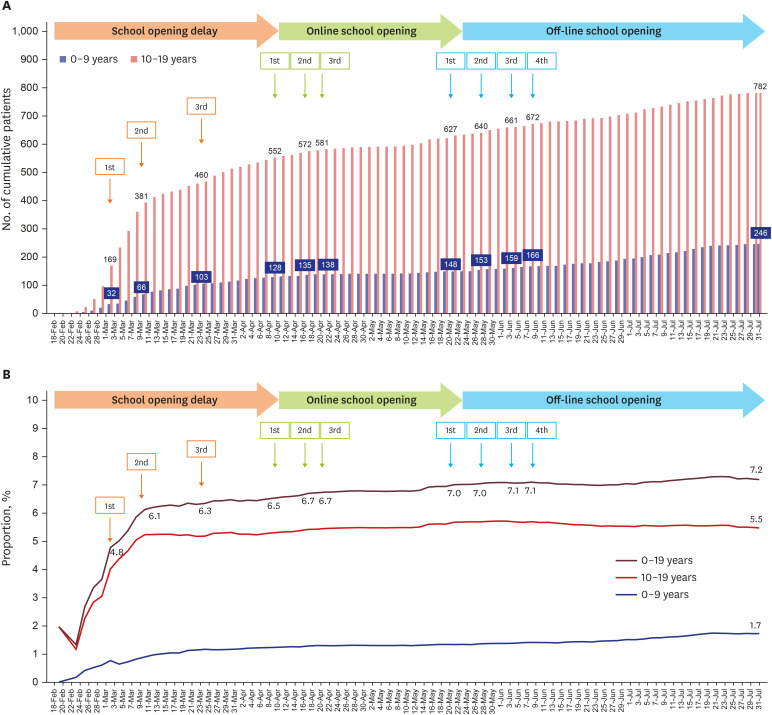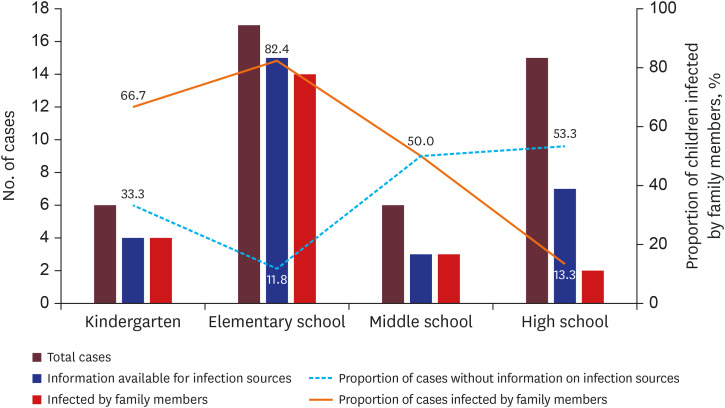J Korean Med Sci.
2020 Dec;35(46):e414. 10.3346/jkms.2020.35.e414.
Stepwise School Opening and an Impact on the Epidemiology of COVID-19 in the Children
- Affiliations
-
- 1Department of Pediatrics, Samsung Medical Center, Sungkyunkwan University School of Medicine, Seoul, Korea
- 2Department of Mathematics, Konkuk University, Seoul, Korea
- KMID: 2509041
- DOI: http://doi.org/10.3346/jkms.2020.35.e414
Abstract
- Background
Data on severe acute respiratory syndrome coronavirus-2 transmission from a pediatric index patient to others at the school setting are limited. Epidemiological data on pediatric coronavirus disease 2019 (COVID-19) cases after school opening are warranted.
Methods
We analyzed data of the pediatric patients with COVID-19 collected from the press release of the Korea Centers for Disease Control and Prevention. Information on the school opening delay and re-opening policies were achieved from the press release of the Korean Ministry of Education.
Results
The school openings were delayed three times in March 2020. Online classes started from April 9, and off-line (in-person) classes started from May 20 to June 8 at four steps in different grades of students. There was no sudden increase in pediatric cases after the school opening, and the proportion of pediatric cases among total confirmed cases in the nation around 7.0%. As of July 31, 44 children from 38 schools and kindergartens were diagnosed with COVID-19 after off-line classes started. More than 13,000 students and staffs were tested; only one additional student was found to be infected in the same classroom. The proportions of pediatric patients without information on infection sources were higher in older age groups than in younger age groups (17.4% vs. 52.4%, P = 0.014). In the younger age group, 78.3% of children were infected by family members, while only 23.8% of adolescents in the older age group were infected by family members (P < 0.001).
Conclusion
Korea had a successful transition from school closure to online and off-line school opening, which did not cause significant school-related outbreak among the pediatric population.
Keyword
Figure
Cited by 2 articles
-
Preparing for the Coronavirus Disease (COVID-19) Vaccination: Evidence, Plans, and Implications
Jaehun Jung
J Korean Med Sci. 2021;36(7):e59. doi: 10.3346/jkms.2021.36.e59.Analysis of Critical COVID-19 Cases Among Children in Korea
Hyunju Lee, Sujin Choi, Ji Young Park, Dae Sun Jo, Ui Yoon Choi, Heayon Lee, Yun Tae Jung, In Hyuk Chung, Young June Choe, Jin Yong Kim, Young-Joon Park, Eun Hwa Choi
J Korean Med Sci. 2021;37(1):e13. doi: 10.3346/jkms.2022.37.e13.
Reference
-
1. Johns Hopkins Coronavirus Resource Center. COVID-19 dashboard by the Center for Systems Science and Engineering (CSSE) at Johns Hopkins University (JHU). Updated 2020. Accessed July 31, 2020. https://coronavirus.jhu.edu/map.html.2. Korean Statistical Information Service. 2018 population census updated by KOSIS, August 29, 2019. Updated 2019. Accessed July 31, 2020. http://kosis.kr/statisticsList/statisticsListIndex.do?menuId=M_01_01&vwcd=MT_ZTITLE&parmTabId=M_01_01#SelectStatsBoxDiv.3. Korean Society of Infectious Diseases. Korean Society of Pediatric Infectious Diseases. Korean Society of Epidemiology. Korean Society for Antimicrobial Therapy. Korean Society for Healthcare-associated Infection Control and Prevention. Korea Centers for Disease Control and Prevention. Report on the epidemiological features of coronavirus disease 2019 (COVID-19) outbreak in the Republic of Korea from January 19 to March 2, 2020. J Korean Med Sci. 2020; 35(10):e112. PMID: 32174069.4. Korea Centers for Disease Control and Prevention. Daily cumulative confirmed data, March 1 to July 31, 2020, Korea. Updated 2020. Accessed July 31, 2020. http://www.cdc.go.kr/.5. UNESCO. COVID-19 impact on education as of July 31. Updated 2020. Accessed July 31, 2020. https://en.unesco.org/covid19/educationresponse.6. Ministry of Education, Student Health information Center. COVID-19 guideline in school settings (2-1th edition). Updated 2020. Accessed July 31, 2020. http://www.schoolhealth.kr/web/bbs/selectNewBBSList.do?lstnum1=3041.7. Ministry of Education. Press release. Updated 2020. Accessed July 31, 2020. http://english.moe.go.kr/boardCnts/list.do?boardID=265&m=0301&s=english.8. Seoul Metropolitan Office of Education. Press release. Updated 2020. Accessed July 31, 2020. http://enews.sen.go.kr/news/list.do?step1=3&step2=1.9. Daegu Metropolitan Office of Education. Notice for off-line class. Updated 2020. Accessed July 31, 2020. http://www.dge.go.kr/main/cm/cntnts/cntntsView.do?mi=5652&cntntsId=32712020.10. Choi SH, Kim HW, Kang JM, Kim DH, Cho EY. Epidemiology and clinical features of coronavirus disease 2019 in children. Clin Exp Pediatr. 2020; 63(4):125–132. PMID: 32252139.
Article11. Kim S, Kim YJ, Peck KR, Jung E. School opening delay effect on transmission dynamics of coronavirus disease 2019 in Korea: based on mathematical modeling and simulation study. J Korean Med Sci. 2020; 35(13):e143. PMID: 32242349.
Article12. Gwangju Metropolitan City. COVID-19 situation of Gwangju. Updated July 31, 2020. Accessed July 31, 2020. https://www.gwangju.go.kr/c19/c19/contentsView.do?pageId=coronagj2.13. Daegu Metropolitan Office of Education. COVID-19 situation. Updated July 31, 2020. Accessed July 31, 2020. http://www.dge.go.kr/main/na/ntt/selectNttInfo.do?nttSn=1744944&mi=5288.14. Daejeon Metropolitan City. COVID-19 situation of Daejeon. Updated July 31, 2020. Accessed July 31, 2020. https://www.daejeon.go.kr/corona19/index.do?menuId=0011.15. Wu Z, McGoogan JM. Characteristics of and important lessons from the coronavirus disease 2019 (COVID-19) outbreak in China: summary of a report of 72 314 cases from the Chinese Center for Disease Control and Prevention. JAMA. 2020; 323(13):1239–1242. PMID: 32091533.16. Whittaker E, Bamford A, Kenny J, Kaforou M, Jones CE, Shah P, et al. Clinical characteristics of 58 children with a pediatric inflammatory multisystem syndrome temporally associated with SARS-CoV-2. JAMA. 2020; 324(3):259–269. PMID: 32511692.
Article17. Han MS, Seong MW, Kim N, Shin S, Cho SI, Park H, et al. Viral RNA load in mildly symptomatic and asymptomatic children with COVID-19, Seoul, South Korea. Emerg Infect Dis. 2020; 26(10):2497–2499. PMID: 32497001.
Article18. Wölfel R, Corman VM, Guggemos W, Seilmaier M, Zange S, Müller MA, et al. Virological assessment of hospitalized patients with COVID-2019. Nature. 2020; 581(7809):465–469. PMID: 32235945.
Article19. Jones TC, Mühlemann B, Veith T, Biele G, Zuchowski M, Hofmann J, et al. An analysis of SARS-CoV-2 viral load by patient age. medRxiv. 2020; 2020.06.08.20125484.
Article20. He X, Lau EH, Wu P, Deng X, Wang J, Hao X, et al. Temporal dynamics in viral shedding and transmissibility of COVID-19. Nat Med. 2020; 26(5):672–675. PMID: 32296168.
Article21. Ludvigsson JF. Children are unlikely to be the main drivers of the COVID-19 pandemic - a systematic review. Acta Paediatr. 2020; 109(8):1525–1530. PMID: 32430964.
Article22. Korea Centers for Disease Control and Prevention. Updates on COVID-19 in Republic of Korea (as of July 9, 2020). Updated 2020. Accessed July 31, 2020. http://ncov.mohw.go.kr/tcmBoardView.do?brdId=&brdGubun=&dataGubun=&ncvContSeq=355336&contSeq=355336&board_id=&gubun=ALL.23. Kim J, Choe YJ, Lee J, Park YJ, Park O, Han MS, et al. Role of children in household transmission of COVID-19. Arch Dis Child. 2020.
Article24. Bunyavanich S, Do A, Vicencio A. Nasal gene expression of angiotensin-converting enzyme 2 in children and adults. JAMA. 2020; 323(23):2427–2429. PMID: 32432657.
Article25. Lu X, Zhang L, Du H, Zhang J, Li YY, Qu J, et al. SARS-CoV-2 Infection in Children. N Engl J Med. 2020; 382(17):1663–1665. PMID: 32187458.
Article26. Posfay-Barbe KM, Wagner N, Gauthey M, Moussaoui D, Loevy N, Diana A, et al. COVID-19 in children and the dynamics of infection in families. Pediatrics. 2020; 146(2):e20201576. PMID: 32457213.
Article27. Lee B, Raszka WV Jr. COVID-19 transmission and children: the child is not to blame. Pediatrics. 2020; 146(2):e2020004879. PMID: 32457212.
Article28. Chu DK, Akl EA, Duda S, Solo K, Yaacoub S, Schünemann HJ, et al. Physical distancing, face masks, and eye protection to prevent person-to-person transmission of SARS-CoV-2 and COVID-19: a systematic review and meta-analysis. Lancet. 2020; 395(10242):1973–1987. PMID: 32497510.
Article29. National Centre for Immunisation Research and Surveillance (NCIRS). COVID-19 in schools – the experience in NSW. Updated 2020. Accessed July 31, 2020. http://ncirs.org.au/sites/default/files/2020-04/NCIRS%20NSW%20Schools%20COVID_Summary_FINAL%20public_26%20April%202020.pdf.30. Heavey L, Casey G, Kelly C, Kelly D, McDarby G. No evidence of secondary transmission of COVID-19 from children attending school in Ireland, 2020. Euro Surveill. 2020; 25(21):2000903.
Article
- Full Text Links
- Actions
-
Cited
- CITED
-
- Close
- Share
- Similar articles
-
- Individual-based simulation model for COVID-19 transmission in Daegu, Korea
- Therapeutics in the Treatment of COVID-19 for Children and Adolescents
- Impact of COVID-19 on the clinical course of nephrotic syndrome in children: a single-center study
- COVID-19 in immunocompromised children and adolescents
- The coronavirus disease 2019 pandemic and chronic diseases




